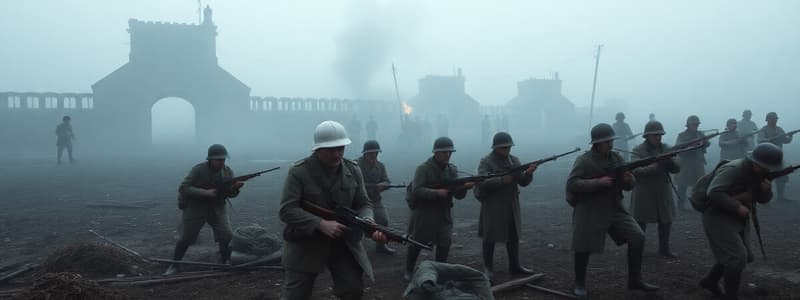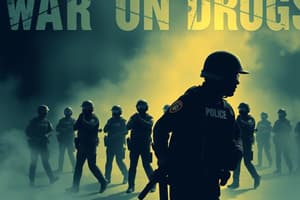Podcast
Questions and Answers
Which of the following strategies best describes the concept of war of attrition as implemented during World War I?
Which of the following strategies best describes the concept of war of attrition as implemented during World War I?
- Rapidly advancing into enemy territory to secure key strategic locations and resources.
- Utilizing highly mobile armored divisions to outflank and encircle enemy forces.
- Employing naval blockades to cut off enemy supplies and starve them into submission.
- Gradually wearing down the enemy through continuous losses of personnel and resources. (correct)
What impact did Germany's policy of unrestricted submarine warfare have on World War I?
What impact did Germany's policy of unrestricted submarine warfare have on World War I?
- It prompted the United States to enter the war, shifting the balance of power to the Allied forces. (correct)
- It led to an immediate armistice and the end of the war due to its devastating effectiveness.
- It had minimal impact as the Allied powers quickly developed effective countermeasures.
- It convinced Russia to remain in the war, preventing the collapse of the Eastern Front.
How did the Treaty of Brest-Litovsk in 1917 significantly alter the course of World War I?
How did the Treaty of Brest-Litovsk in 1917 significantly alter the course of World War I?
- It allowed Germany to transfer troops from the Eastern Front to the Western Front after Russia's exit. (correct)
- It brought Italy into the war on the side of the Central Powers, strengthening their position.
- It established a new alliance between Russia and the Allied Powers against Germany.
- It created a neutral zone in Eastern Europe, preventing further conflict in the region.
What was the primary objective of the Zimmermann Telegram during World War I?
What was the primary objective of the Zimmermann Telegram during World War I?
In the context of World War I, how did nationalism contribute to the outbreak and escalation of the conflict?
In the context of World War I, how did nationalism contribute to the outbreak and escalation of the conflict?
How did the introduction of chlorine gas at the Second Battle of Ypres in 1915 impact the course of World War I?
How did the introduction of chlorine gas at the Second Battle of Ypres in 1915 impact the course of World War I?
What was the significance of the Battle of Vimy Ridge in 1917 for the Canadian Corps during World War I?
What was the significance of the Battle of Vimy Ridge in 1917 for the Canadian Corps during World War I?
How does the political ideology of socialism differ from that of capitalism?
How does the political ideology of socialism differ from that of capitalism?
Which statement accurately describes the role of Sam Hughes, the Canadian Minister of Militia, during World War I?
Which statement accurately describes the role of Sam Hughes, the Canadian Minister of Militia, during World War I?
What was the main promise of the Bolsheviks' slogan 'Peace, Bread, and Land' during the Russian Revolution?
What was the main promise of the Bolsheviks' slogan 'Peace, Bread, and Land' during the Russian Revolution?
Flashcards
Sam Hughes
Sam Hughes
Canadian Minister of Militia during WWI, known for mobilization efforts but criticized for poor equipment choices like the Ross Rifle.
Battle of Ypres, 1915
Battle of Ypres, 1915
First major battle for Canadian troops; marked by Germany's initial use of chlorine gas, leading to many casualties.
War of Attrition
War of Attrition
A military strategy where belligerents attempt to win a war by wearing down the enemy to the point of collapse through continuous losses in personnel and materiel.
Kaiser Wilhelm II
Kaiser Wilhelm II
Signup and view all the flashcards
Vimy Ridge, 1917
Vimy Ridge, 1917
Signup and view all the flashcards
Unrestricted Submarine Warfare
Unrestricted Submarine Warfare
Signup and view all the flashcards
The Armistice, 1918
The Armistice, 1918
Signup and view all the flashcards
Capitalism
Capitalism
Signup and view all the flashcards
Liberalism
Liberalism
Signup and view all the flashcards
Communism
Communism
Signup and view all the flashcards
Study Notes
Key Figures and Events in WWI
- Sam Hughes served as the Canadian Minister of Militia during WWI
- Hughes was responsible for mobilization
- Hughes received criticism for inefficiency and poor equipment choices such as the Ross Rifle.
- The Battle of Ypres in 1915 marked the first major battle for Canadian troops.
- Germany used chlorine gas for the first time at The Battle of Ypres
- Billy Bishop was a Canadian flying ace.
- Bishop was credited with 72 aerial victories.
- War of Attrition involved wearing down the enemy through continuous losses over time.
- "A Place in the Sun" by Bernhard von Bülow symbolized Germany’s imperial ambitions before WWI.
- The Battle of the Somme in 1916 resulted in over a million casualties.
- Tank warfare was introduced at The Battle of the Somme.
- Chlorine Gas was first used by Germany at Ypres.
- Chlorine Gas caused blindness, suffocation, and death.
- The Battle of Gallipoli in 1915 marked a failed Allied campaign against the Ottoman Empire.
- Mutiny involves the refusal to obey military orders.
- Mutiny often happened due to poor conditions or leadership.
- Arthur Currie was the first Canadian commander of the Canadian Corps.
- Currie led troops at Vimy Ridge.
- The Battle of Beaumont-Hamel during the Somme was a devastating loss for the Newfoundland Regiment.
- "Shock Troops" refers to elite Canadian soldiers who led assaults in the later years of WWI.
- Vimy Ridge in 1917 marked a major Canadian victory.
- Vimy Ridge became a symbol of national pride and military success.
- Nationalism is a strong identification with one’s nation.
- Nationalism was often a cause of WWI.
- The Battle of Passchendaele in 1917 was muddy and brutal.
- Canadians captured key territory at a high cost at The Battle of Passchendaele.
- Isolationism is avoiding political or military involvement with other countries.
- Alfred Zimmermann was a German diplomat.
- Zimmermann sent the Zimmermann Telegram
- The Zimmermann Telegram encouraged Mexico to join WWI against the U.S.
- Unrestricted Submarine Warfare was Germany’s policy of sinking ships without warning.
- Unrestricted Submarine Warfare was a key reason for U.S. entry into WWI.
- Rasputin was a Russian mystic.
- Rasputin influenced the Russian royal family before the 1917 Revolution.
- "Peace, Bread, and Land" was the slogan of the Bolsheviks.
- The slogan "Peace, Bread, and Land" promised solutions to Russia’s problems.
- The 1917 Treaty of Brest-Litovsk marked Russia’s exit from WWI.
- Russia ceded territory to Germany as part of The 1917 Treaty of Brest-Litovsk.
- Kaiser Wilhelm II was the German Emperor.
- Kaiser Wilhelm II abdicated in 1918.
- The Armistice in 1918 was a ceasefire ending WWI on November 11, 1918.
- The "14 Points" was Woodrow Wilson’s peace plan for post-WWI Europe.
- Article 231 of the Treaty of Versailles is also known as the "War Guilt Clause".
- Article 231 blamed Germany for WWI and imposed reparations.
- The Victoria Cross is the highest British military honor awarded for bravery.
Political Ideologies
- Feudalism was a Medieval social system.
- Feudalism was based on land ownership and hierarchy.
- Capitalism is an economic system.
- Capitalism is based on private ownership and profit.
- Liberalism is a political ideology.
- Liberalism emphasizes individual freedoms and democracy.
- Socialism is an economic system.
- Socialism involves production being controlled by the community or state.
- Communism is an ideology.
- Communism advocates classless society and common ownership of resources.
- Anarchy is the absence of government or authority.
Studying That Suits You
Use AI to generate personalized quizzes and flashcards to suit your learning preferences.




